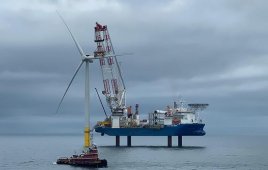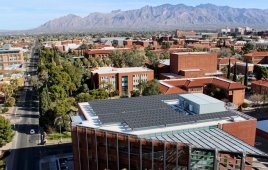This article comes from law firm Morgan Lewis and is authored by Kenneth M. Kulak, Stephen M. Spina and Pamela Tsang Wu
The proposed rule recognizes the physical and operational characteristics of electric storage resources and distributed energy resource aggregators and removes barriers to their participation in organized wholesale electric markets.
After seeking comments on the potential barriers that affect the participation of electric storage resources in organized wholesale markets earlier this year, the Federal Energy Regulatory Commission (FERC) issued a notice of proposed rulemaking (NOPR) that would require each regional transmission organization (RTO) and independent system operator (ISO) to revise their tariffs to establish a participation model that accommodates the participation of electric storage resources in the organized wholesale markets.[1] This participation model must consist of market rules that recognize the physical and operational characteristics of electric storage resources and must, among other things, ensure that these resources are eligible to provide all capacity, energy, and ancillary services that they are technically capable of providing in organized wholesale electric markets. FERC also proposes to require each RTO and ISO to revise their tariffs to establish distributed energy resource aggregators as a type of market participant to address barriers to their participation in the organized wholesale electric markets. We will discuss this NOPR in further detail during an upcoming webinar on November 29.
Electric storage resources, as defined by FERC, are resources that are capable of receiving electric energy from the grid and storing the energy for later injection back to the grid regardless of where the resource is located on the electrical system. Such resources include all types of electric storage technologies, regardless of their size, storage medium (e.g., batteries, flywheels, compressed air, pumped-hydro, etc.), and location. Distributed energy resource aggregators are entities that aggregate one or more distributed energy resources for purposes of participation in the organized wholesale capacity, energy, and ancillary service markets of RTOs and ISOs. Distributed energy resource aggregators include electric storage resources.
The responses to the Data Requests and Request for Comments that FERC issued in April[2] highlighted the limitations on the types of service that these resources can provide. For example, some electric storage resources participated as demand response resources because that was the participation model that most closely resembled the manner in which electric storage resources might participate in organized wholesale markets. However, those participation models do not account for an electric storage resource’s physical and operational characteristics.
The proposed participation model for electric storage resources must meet several requirements:
- The participation model must ensure that electric storage resources are eligible to provide all capacity, energy, and ancillary services that they are technically capable of providing in the organized wholesale electric markets.
- The participation model must incorporate bidding parameters that reflect and account for the physical and operational characteristics of electric storage resources.
- Each RTO and ISO must revise their tariffs to ensure that electric storage resources can be dispatched and can set the wholesale market clearing price as both a wholesale seller and wholesale buyer consistent with existing market rules that govern when a resource can set the wholesale price.
- The participation model must establish a minimum size requirement for participation in the organized wholesale electric markets that does not exceed 100 kW.
- Each RTO and ISO must revise their tariffs to specify that the sale of energy from the organized wholesale electric markets to an electric storage resource that the resource then resells back to those markets must be at the wholesale locational marginal price.
FERC also proposes to require that each RTO and ISO accommodate the participation of distributed energy resource aggregations in the organized wholesale electric markets. In particular, FERC seeks to remove barriers to participation by the new distributed energy resources that are smaller, interconnected to lower voltage networks, and geographically dispersed. These resources often do not meet the minimum size requirements to participate in the markets under existing participation models and may have difficulty satisfying all of the operational performance requirements because of their small size. Allowing these resources to participate in the organized wholesale markets through distributed energy resource aggregations can help overcome the minimum size and performance requirements that the resources would not have been able to satisfy by themselves. FERC noted that the most commonly cited example of the barriers are market rules that relegate electric storage resources, particularly behind-the-meter electric storage resources, to participating in demand response programs.
FERC proposes that each RTO and ISO revise their tariffs to allow distributed energy resource aggregators to participate in the organized wholesale electric markets and establish market rules consistent with the following:
- Eligibility to participate in the organized wholesale electric markets through a distributed energy resource aggregator
- Locational requirements for distributed energy resource aggregations
- Distribution factors and bidding parameters for distributed energy resource aggregations
- Information and data requirements for distributed energy resource aggregations
- Modifications to the list of resources in a distributed energy resource aggregation
- Metering and telemetry system requirements for distributed energy resource aggregations
- Coordination among the RTO or ISO, the distributed energy resource aggregator, and the distribution utility
- Market participation agreements for distributed energy resource aggregators
If implemented, the proposed rules will provide more opportunities for electric storage resources and distributed energy resource aggregators to participate in the organized wholesale electric markets. The NOPR should also enhance competition in the markets and incentivize developers to design and invest in new technologies. Each RTO and ISO would be required to submit a compliance filing within six months of the date that the Final Rule is published in the Federal Register, and the proposed reforms would need to be implemented within 12 months of the date of the compliance filing.
Comments on the NOPR are due 60 days after it is published in the Federal Register. Access the original here.
Filed Under: Energy storage, Policy





